Who Are Your Filth Elders? A Discussion with Emily Colucci and Alexandria Deters


Do you remember the first person that you really looked up to? Having a role model or someone you greatly admire is a funny concept. When you are a child, your role models are normally people you know─your family, your teacher, your siblings because those are the people in your orbit─ but you don’t think too much about it since it just clicks. Hopefully, that person exhibits positive behavior or teaches you something that you can learn from. As you grow older, your role models extend to people you might not necessarily know, but you see something in them. It could be a conscious or subconscious choice. It might be because you think both of your personalities are similar, you admire how he or she presents themselves, or something they’ve done has blown you away and you can’t get it out of your head.
You might be wondering, what’s all this talk about role models and what does this have to do with the art world? The people that we idolize play a very strong role in “Idol Worship,” a new group exhibition up at Smack Mellon (on view through December 29th). Partially inspired by John Waters’ “Role Models,” this exhibition celebrates the ongoing cultural, social and political significance of role model adoration as an essential survival strategy. The more I think about it, the more my mind is blown about the nuances and subtleties of the work on view (while it wasn’t a requirement for submission, a number of the other artists are familiar with Waters’ different movies, which was an added bonus for me to learn about since I knew next to nothing about him) as well as how formative role models are in the development of our identities and sense of self.
I had the opportunity to sit down with Emily Colucci, curator of “Idol Worship” and Alexandria Deters, gallerist at Peter Blum Gallery and one of the artists included in the show. Colucci and Deters are both movers and shakers in the art world, so as 2019 soon comes to a close, tune in to our discussion about the premise of “Idol Worship,” the impact John Waters’ work (self-proclaimed filth elder) has had on both of them, fandom bordering on fanatics, cults, and much, much more.
In preparation for this interview, I re-read the press release and all I can say, WOW! I’m a huge fan of sharp, witty and to the point press releases. Emily, I love that you really define what a ‘role model’ means in the context of this exhibition. Can you speak to a little about how you came up with this unique idea for an exhibition? Did this exhibition grow out of Filthy Dreams?
Emily Colucci: The concept behind “Idol Worship” comes from a few different inspirations, including John Waters’ pseudo-autobiography “Role Models,” but essentially it’s a completely personal show. The quote that I use from John Waters in the press release, “Life is nothing if you’re not obsessed,” could be my personal mantra. I’ve always fixated on certain figures–from Disney villains when I was a child to being completely fanatical over Nick Cave, Lana Del Rey, Grimes and Azealia Banks now. In a way, this show is my way of trying to create a community of the unhinged inside Smack Mellon. Speaking personally, I’ve found–and this show argues that others find–role model adoration to be a type of survival strategy that extends throughout our lives.
But beyond the personal, for a few years, I’ve noticed and been drawn to visual art that specifically engages with role models. One piece that was formative to the exhibition, which is actually in the show, is Michelle Handelman’s film “Irma Vep, The Last Breath.” The film features the late drag mother to us all Flawless Sabrina and the already role model-worthy Zackary Drucker playing, respectively, early 20th-century actress, feminist and lover of Collette, Musidora, and her best-known character, criminal mastermind, Irma Vep (from 1915’s “Les Vampires”). From the real-life intergenerational friendship between Flawless Sabrina and Drucker to the discovery of Musidora as an early queer woman icon, the film portrays a multi-layered–not to mention gorgeously filmed–approach to queer and feminist lineage and mentorship.
And yes, the show unquestionably grew out of Filthy Dreams, a blog I co-founded in 2013, which, according to our description, analyzes art, culture, and politics with a touch of camp. But, really, we cover just about whatever the hell we want. I should preface, “Idol Worship” isn’t unique in its connection to Filthy Dreams. The previous exhibitions I’ve curated–”Party Out Of Bounds: Nightlife As Activism Since 1980″ at La MaMa Galleria and “Night Fever” at Pittsburgh’s Future Tenant–also evolved from ideas I was already tangling with in my writing on the site. For Idol Worship specifically, Filthy Dreams has an ongoing series “Role Models” in which we pay tribute to our faves like disco divas Donna Summer and Amanda Lear, trans punk pioneer Jayne County and bald Downtown drag legend Dean Johnson. But, more generally, the tone of Filthy Dreams tends toward fanatical and over-the-edge, both of which seem to lend themselves to the tenor of the exhibition.
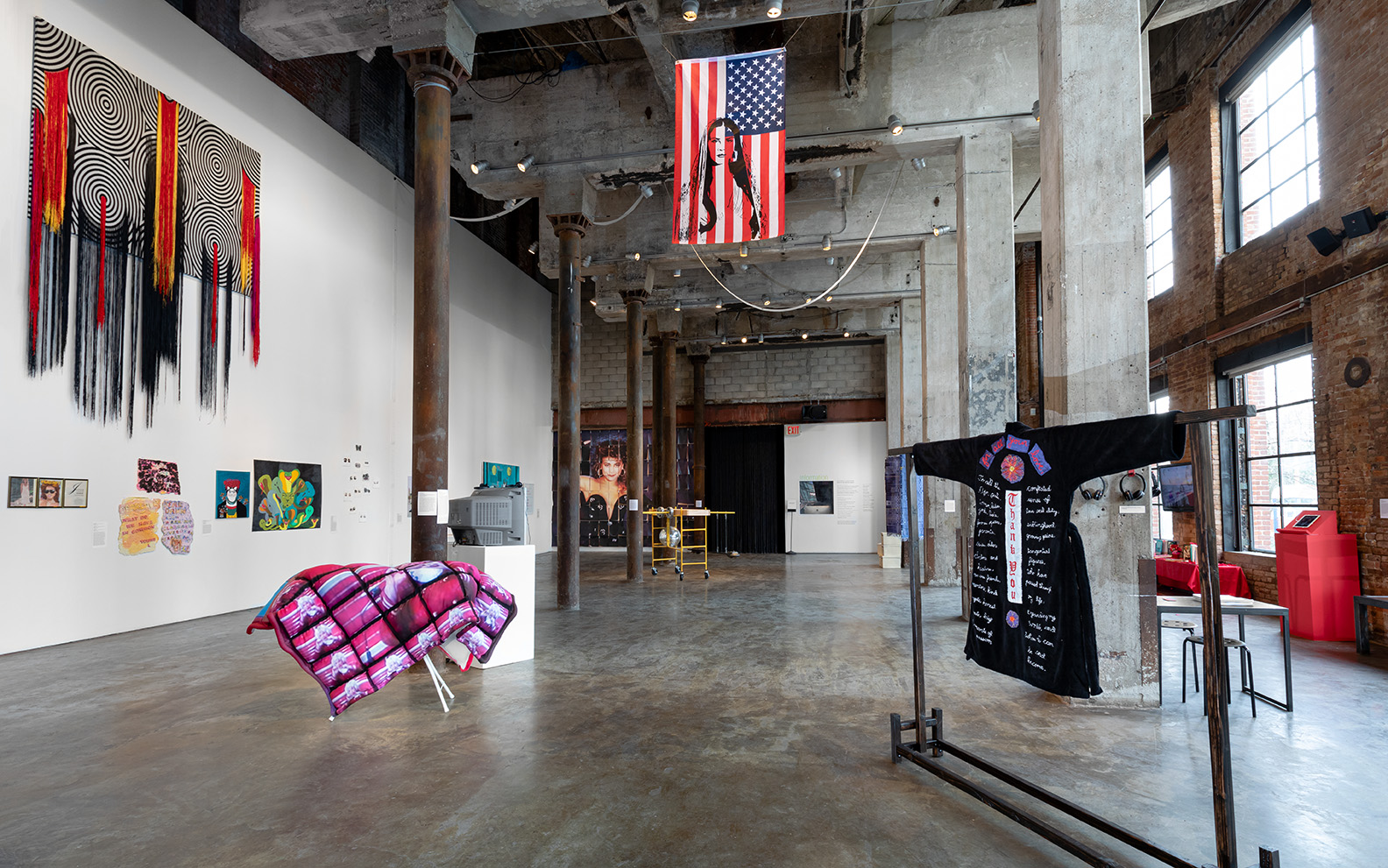 Previous and above: Idol Worship,” installation views. Images courtesy of Smack Mellon. Photo: Etienne Frossard
Previous and above: Idol Worship,” installation views. Images courtesy of Smack Mellon. Photo: Etienne Frossard
Were both of you really familiar with the work of John Waters prior to this exhibition? I honestly wasn’t, but now I see why “Role Models” fits in so well in with the theme. What about the rest of the artists?
E: If I were any more of a John Waters fan, I’m sure he’d have an order of protection against me. Yes. Yes. I was really familiar. I think watching his film “Pink Flamingos” in college altered my brain chemistry (along with reading experimental fiction novelist Dennis Cooper). If we’re talking about idol worship, he’s probably one of the filth elders (his term) I’ve been the most devoted to: my patron saint of trash. But, with the exhibition, John’s never been shy to acknowledge and celebrate his many diverse influences, which culminated in his book “Role Models.” In “Role Models,” he details everyone from Tennessee Williams (one of the filth elders we share) to Johnny Mathis to Zorro, a stripper from Baltimore with the face of Johnny Cash, to Manson Family member Leslie Van Houten. Not just a fantastic character study of these people specifically, it also becomes a portrait of Waters through his influences. We take certain parts of our role models with us, and they make up who we are in a strange, but also beautiful way.
A lot of the artists in the show do happen to be John Waters fans, but that’s more of a coincidence. It’s not as if only selected artists based on their fandom or forced them to watch “Female Trouble” until they finally understood the magnitude of its genius. However, some of the actresses that starred in John’s films do make appearances in “Idol Worship,” such as Cookie Mueller and Edith Massey, who are represented by their iconic eye makeup in drawings by Tatyana Gubash.
A: Indeed I was! The first John Waters’ film I watched was “Serial Mom” (1994) during the late 1990s while visiting my mother’s family in Georgia. I thought his sense of humor was hilarious. Later, I watched “Hairspray” (the wonderful 1988 version as well as the 2007 musical) and “Crybaby” in high school, and that’s when my fascination with him really started. Long story short: I watched “Pink Flamingos” in college and was blown away by the film and its protagonist played by Divine, a drag queen, and he has been one of my favorite directors ever since.
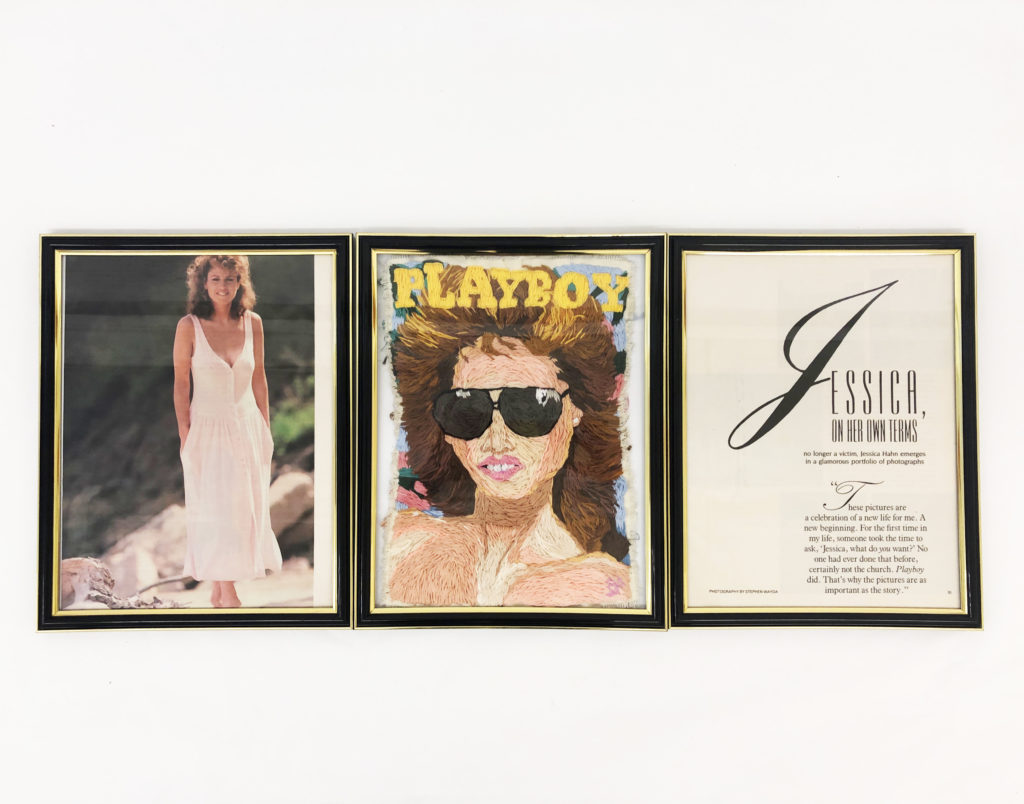
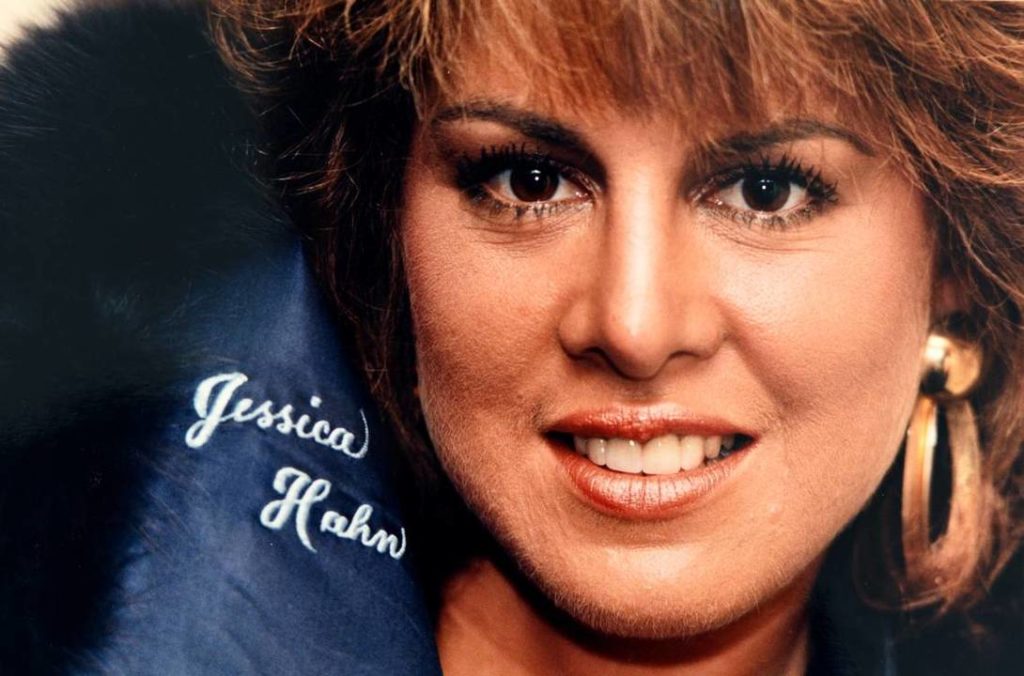
Previous: Alexandria Deters. “November 1987 (Jessica Hahn: Born Again),” newspaper, embroidery, and mixed media. Above: The real Jessica Hahn. Photo courtesy of The Charlotte Observer.
Alexandria, there is so much to unpack behind Jessica Hahn’s backstory. I read an article in the Charlotte Observer, and found it interesting that the shame left over from the Jim Bakker scandal blended into her feeling ashamed for the time spent posing for Playboy. Even all these years later, those feelings haven’t died down, and are still very much part of Jessica’s life. I think you mentioned that this is part of a larger series you are working on? How did this series begin and where did you track down copies of old Playboys?
A: There is definitely a lot to unpack when looking at and trying to understand all the complexities of the Jessica Hahn story! It does make me sad that she feels shame about posing for Playboy, but how could she not when she was destroyed in the media for it, and her story got lost over the years with acting gigs, going on The Howard Stern Show multiple times over the years, and even posing for Playboy again in 1988. For me (reading the Charlotte Observer article you mentioned), I see the shame she is talking about more relating to the shame every survivor of assault/rape/abuse has. And part of that shame is trying to learn how to move on, and a lot of times when trying to heal you try new things to attempt to re-find yourself. I understand why she looks at that time of her life not positively.
But for me, I see her as truly remarkable. Being able to tell her story and pose nude, especially when her rapist and his entire church was demonizing her calling her “the other woman.” That takes guts and bravery that I don’t even know that I have. When looking at Jessica Hahn, I saw a woman that while she was nude (which is wonderful by the way, the ability to love your body and be confident in who you are), people and history were forgetting, or ignoring, a much more important and interesting part of this photoshoot and the story. That she was a victim and instead of letting her abusers dictate the narrative, her being in Playboy was her taking back her agency and voice.
My friend John Hanning sent me an email about the open call for “Idol Worship” and reading the description of the show inspired me to embroider and relook at Jessica Hahn’s story. Through that and other research, it has blossomed into a much larger series which currently consists of four parts, and will be made of images and materials from the Playboy issues: November 1987, December 1987, December 1988; and the October 1987 issue of Penthouse in which Jessica was interviewed.
I have always been interested in the “sex” industry and its history, and how it overlaps with feminism and queer culture. When the open call was announced, I had recently purchased a few vintage porn magazines at a Brooklyn secondhand store and the November 1987 issue of Playboy was one of them. My favorite way of acquiring materials for my works and research is finding old magazines randomly while digging around in thrift shops and used bookstores like Codex and Mast bookstores, but I have now started looking for specific issues of magazines and eBay has become my new best friend.
I’m also so curious about how you began embroidering, and how it became your chosen medium!
A: I learned how to do embroidery and other forms of textile (such as felting but oof, not good at that!) while in college at San Francisco State University. I love the ability to be able to do it everywhere, and being a very tactile person with intense anxiety, I love the ability to be able to really handle and touch my work. The repetitive motions and having to directly focus while I’m working is very, very calming. For me, it is like meditation. I could never see myself not doing embroidery because I love sharing my art with the world, but in the end, I am doing this for me and because I believe the stories and people I am focusing on need to be relooked at and have their stories told in a new light. Also, I can now fix my clothes pretty decently if there is a hole!
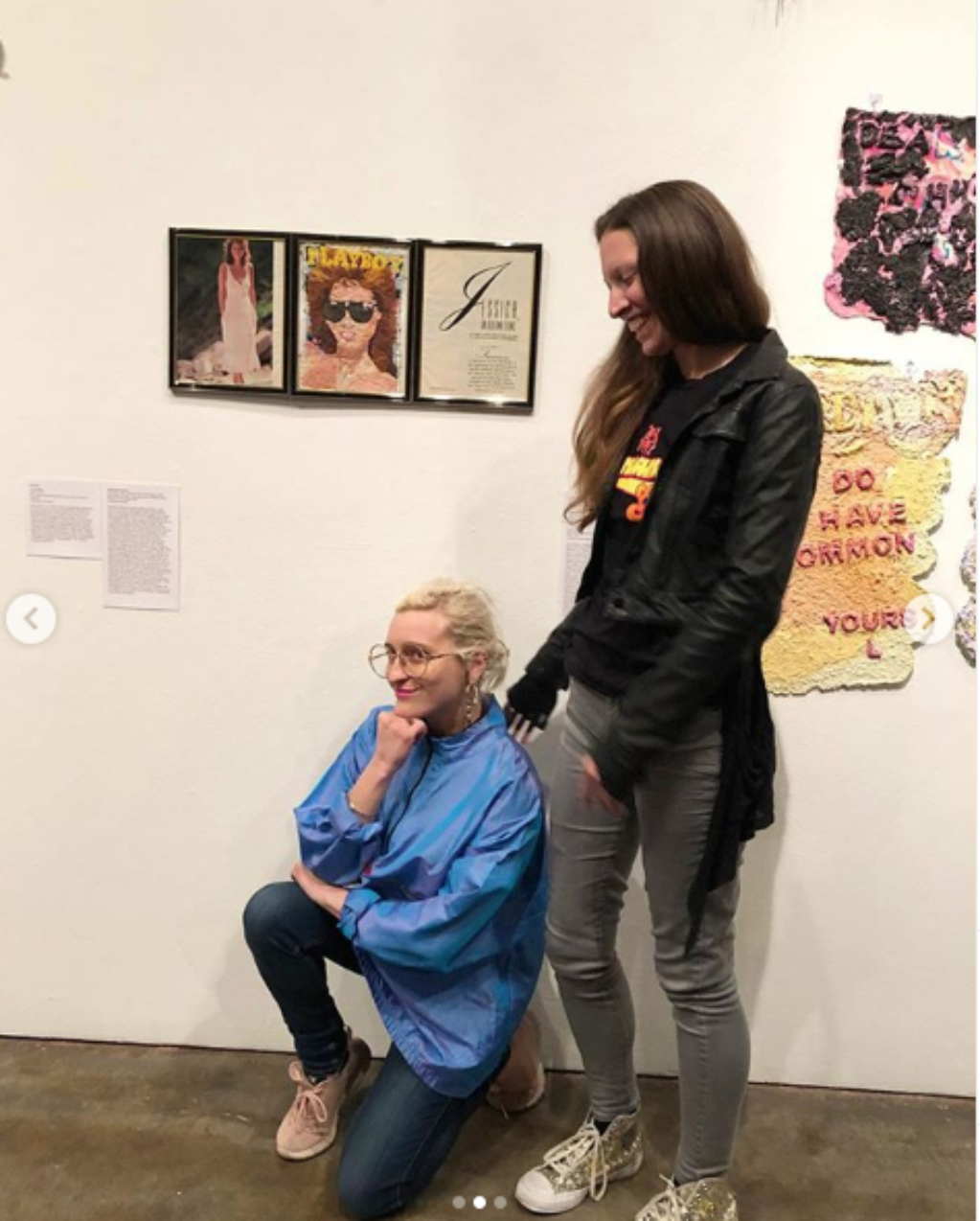 Left to Right: Alexandria Deters and Emily Colucci
Left to Right: Alexandria Deters and Emily Colucci
How did the two of you meet? Is this the first time you’ve worked together?
E: Yes, it’s the first time we worked together. “Idol Worship” was partially curated through an open call for emerging artists (my curatorial proposal was also selected by Smack Mellon through an open call for emerging curators). In going through the nearly 400 open call submissions, I saw Alexandria’s work “November 1987 (Jessica Hahn: Born Again)” and fell in love with it. I mean, why shouldn’t we celebrate porn stars? While I was familiar with Hahn through her appearances on The Howard Stern Show, I didn’t know the entire story about her rape by Jim Bakker (though I was familiar with his heroically mascara-drenched wife Tammy Fae who does deserve to be recognized for her treatment of people with AIDS), and subsequent reclamation of her agency, body and story by posing in Playboy. I was interested not only in Hahn’s backstory, but in Alexandria’s embroidery, which in its exhausting repetition and tactility seemed to make the devotion to Hahn physical.
So after I selected Alexandria from an open call, we met at a coffee shop in Soho for a lovely chat and the rest is history!
A: Oh my goodness I did not realize that many people applied! I am glad my work caught her eye!
And yes, this is the first time we have worked together and I was so nervous for my studio visit that day! I had heard of Emily and her wonderful curatorial eye through my friend John Hanning. He said, “You know the exhibition “Party Out of Bounds: Nightlife As Activism Since 1980” that Visual AIDS put on in 2015? She co-curated that!” I have that publication that Visual AIDS put out for the exhibition and I just thought it was amazing (and that she must be the coolest person ever, which she is).
But once we met I realized I had nothing to be nervous about because she was nice and wonderful. As an artist, I feel very well-taken care of and listened to working with her.
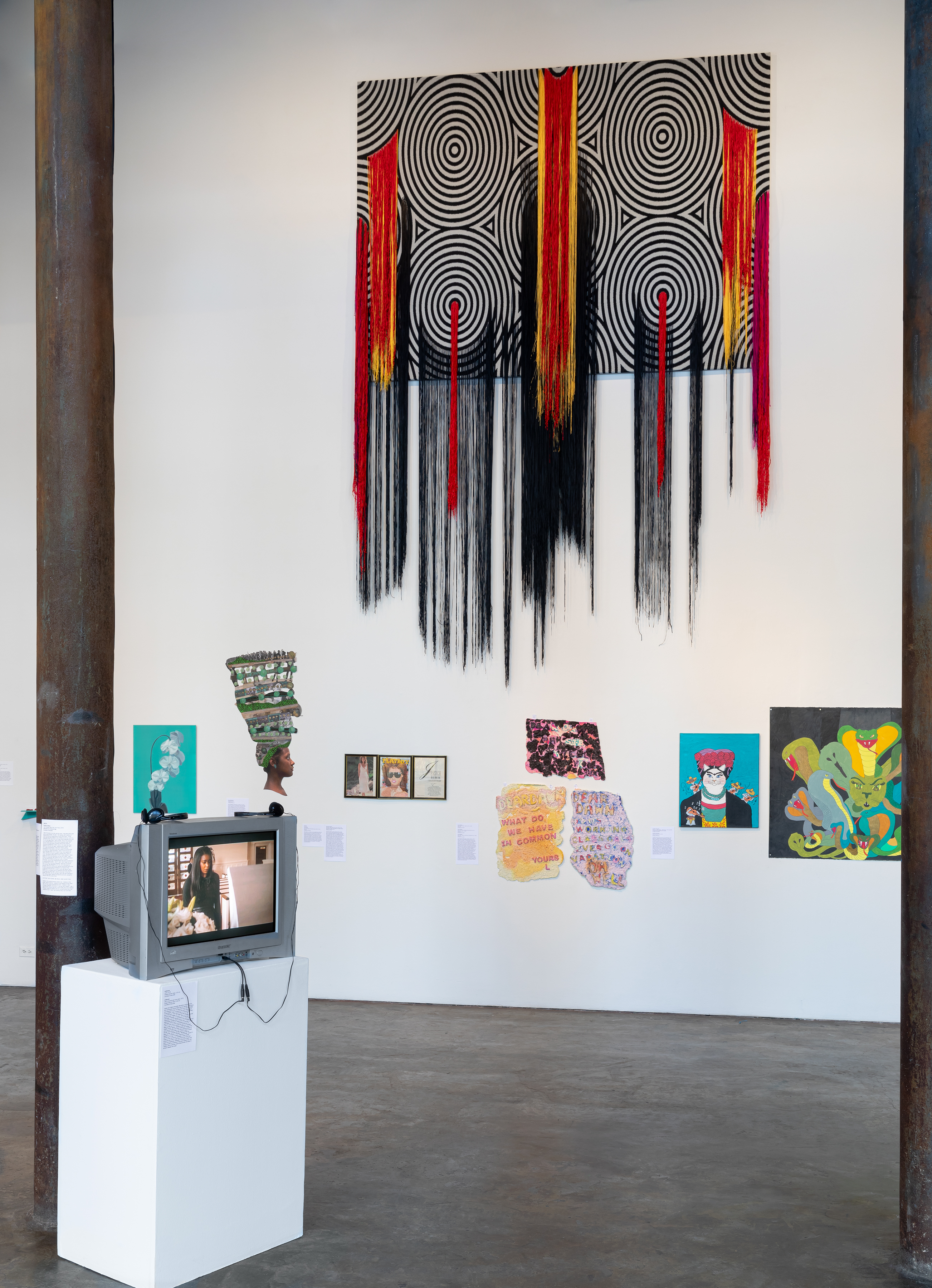
As 2019 soon comes to a close, what are some takeaways that you’d like to share with other female artists, or to share generally? I ask since the art world is hectic, and can be so overwhelming (with everyone trying to figure out how they do or don’t fit into it). You are both two very talented ladies who curate, write, and make art.
E: I’d say specifically don’t try to fit in. Not in a misunderstood “Rebel Without A Cause” sense, but do the work that makes you happy and forget all the rest of the art world’s social-climbing bs. Now, will that bring monetary success or any kind of social capital that will get you invited to opening after-party dinners? Probably not. But you’ll be happier as a person, and specifically as a creative person. I see so many artists get bogged down worrying about so much of the social and hierarchical aspects of the art world. Typically if you do what you love, you’ll find some sort of kinship and community, even if it’s not celebrated by blue-chip galleries. And anyway transgression, subversion or any sort of change never came from being an insider, or merely doing what the dominant culture thinks it’s looking for. Speaking personally, I, particularly through Filthy Dreams, strive to continually exist at the margins. It provides such freedom.
Also don’t take anything too seriously. Drawing on a quote from performer Ann Magnuson, if you take nothing seriously, “that can be an affront to people who are taking things way too seriously.” A prime example is “Idol Worship.” While the artists in the show do take their idols seriously and sincerely, the show has a sense of humor, which, at least to me as its curator, seemed like a breath of fresh air in the all-too-serious art world of 2019.
A: Thank you so much for your kind words! You are quite a talented individual yourself! I will have to concur with Emily, trying to fit in is so exhausting and overwhelming, especially in the art world. I have learned that being myself and focusing on my goals is really the best way to be happy and succeed. While I do go to openings and shows, etc., I no longer feel the need to go to all of them–influencer culture I think is burning everyone out, like screw it just go to things that you like and enjoy, and make art that you care about even if does make your family blush. Especially because most of the art I enjoy, and my own art, is reported on Instagram, I learned pretty quickly if I was living for the likes i would be metaphorically dead.
As an artist and writer, networking is important, but you have to always remember the most valuable thing you have is time. And with that in mind, I no longer care (most of the time) what others might think and I don’t waste my time going to exhibits or openings because it is on some top 10 list. And when you live that way, people take your opinions and thoughts more seriously because they know you are being genuine and thoughtful.
So be yourself, post what you want (or don’t post at all!), go to an opening or stay inside with a good book or Netflix, whatever. What is most important is to learn what makes you happy and do it because in ten years, do you want to look back and say “Wow I wasted so much of my time and worried so much because of x, y, and z?”
I know that I don’t worry anymore and it feels like life is a bit lighter and brighter now.
What else is coming down the pipeline?
E: In terms of curating, I feel as though I’m still recovering from the “Idol Worship” installation, which you’ll notice was quite manic and ambitious. I tend to take my time between exhibitions. I’ve curated a show every two years since 2015 so we’ll see this time around. That being said, I do have some ideas rolling around in my head that I’ll keep refining. To give a hint, I’m thinking a whole lot about cults, which, depending on how the 2020 election goes (with Trump supporters who I’d argue are a cult), could end up being an absolutely timely exhibition. Of course, in the meantime, I’ll keep hurling my missives from Filthy Dreams.
A: Well hopefully lots of cookies over the holiday season! Ha! But mostly I will be continuing to work on my Jessica Hahn series and other people that have been in “dirty magazines” and their stories (so lots of research, a lot of old porn to look at) and my “Send N00dz” series. While working on my own art, my other passion is helping my artistic community and that includes for me writing on the art world in reviews, artist interviews, and opinion pieces. So lots of studio visits and openings to attend! I also will have work on view in the Visual AIDS upcoming annual fundraising exhibition “Postcards From the Edge,” which will be on view from January 3-5, 2020 at Bortolami Gallery in Tribeca. However! Everyone in the show is anonymous, so you will have to attend to discover which piece is mine!
Don’t miss it! “Idol Worship” is on view through December 29, 2019 at Smack Mellon, located at 92 Plymouth Street, Brooklyn, NY.
Related Articles
What's Your Reaction?
Writer, Cultbytes PR specialist. Alexandra Israel graduated from Bates College in 2010. A museum aficionado since her introduction to Jean Dominque Ingres' portraits as a small child, she enjoys spending her free time at museums and finding off-the-beaten-track gallery shows. Israel has been working in PR for over seven years, primarily within book publishing and in the art world. She has held positions at Penguin Book Group, Aperture Foundation, and Third Eye among others. l igram l


